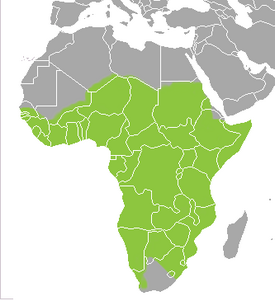Mamba [1] ( lat. Dendroaspis ) is a genus of snakes from the family of aspids living in Africa .
| Mamba |

Black Mamba |
| Scientific classification |
|---|
| No rank : | Bilateral symmetrical |
| Infraclass : | Lepidosauromorphs |
| Infrastructure : | Caenophidia |
|
| International scientific name |
|---|
Dendroaspis ( Schlegel , 1848) |
| Area |
|---|

|
|
Content
The total length reaches 2-3 m. These are long and slender, thin-tailed snakes with a narrow chiseled head and large eyes. On the upper jaw they only have 2 very long poisonous fangs. On the lower jaw, 2 front teeth are greatly enlarged, which helps them to keep prey in the air when it is necessary to eat it on the branches of a tree. Coloring is in perfect harmony with the environment - green, brown, black.
They inhabit tropical forests , live in abandoned burrows or piles of stones. It moves on the ground, in rare cases, climb trees and shrubs . Active at night or day. These snakes are extremely dexterous, fast and usually bite without warning. They feed on small vertebrates - birds , lizards , rodents .
These are ovipositing snakes. The female lays 15 eggs.
Found in sub- Saharan Africa .
The poison of mamb is extremely toxic and kills a small rodent in a few seconds. A person can die from a bite of a mamba within half an hour. After a bite, mambas try to bite several more times. Their venom contains various neurotoxins and has a nerve-paralytic property (the victim suffocates). A bite of a mamba without taking an antidote ends, as a rule, with death. The most dangerous is a bite into a vein , since only a few minutes remain for rescue therapy. This creates a legitimate fear of mambas among the local population. However, numerous stories of the deliberate attack of mambas on people are a manifestation of fantasy. Such cases, if they happened, were caused by an unexpected collision with mambas, which in such circumstances are usually protected by a lightning bite.
As of September 2018, 4 species are included in the genus [2] :
- Dendroaspis angusticeps (Smith, 1849) - Narrow - headed mamba
- Dendroaspis jamesoni (Traill, 1843) - James Mamba
- Dendroaspis polylepis (Günther, 1864) - Black Mamba
- Dendroaspis viridis (Hallowell, 1844) - The Green Mamba , or Western Mamba
- ↑ Ananyeva N. B. , Borkin L. Ya. , Darevsky I.S. , Orlov N.L. The five-language dictionary of animal names. Amphibians and reptiles. Latin, Russian, English, German, French. / edited by Acad. V. E. Sokolova . - M .: Rus. Yaz., 1988 .-- S. 345 .-- 10,500 copies. - ISBN 5-200-00232-X .
- ↑ The Reptile Database: Dendroaspis
- Schlegel, 1848: Over Elaps Jamesonii Traill. Kort Verslag der Werkzaamheden verrigt door de leden van de commissie voor Bijdragen tot de Dierkunde, in het Lokaal van het Zoologisch Genootschap onder de zinspreuk: Natura Artis Magistra , te Amsterdam, p. five.
- Jan Knappert (1 January 1985). Myths and Legends of Botswana, Lesotho, and Swaziland . Brill Archive. pp. 53–. ISBN 90-04-07455-4 .
- Alfred Burdon Ellis (1887). South African Sketches . Chapman and Hall.
- National Geographic (Black Mamba, Dendroaspis polylepis) (neopr.) . National Geographic Society . - " African myths exaggerate their capabilities to legendary proportions; Black mambas are shy and will almost always seek to escape when confronted . ".

